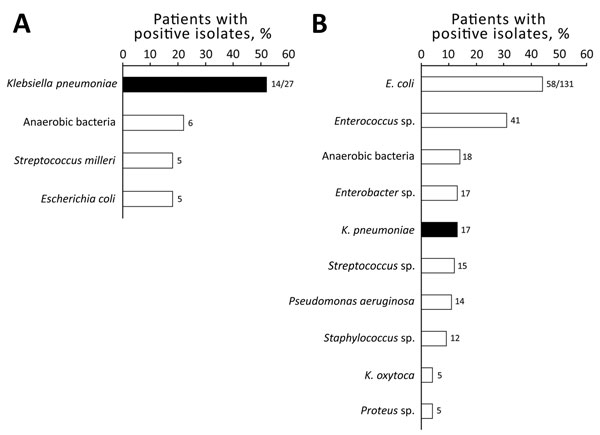Hypervirulent Klebsiella pneumoniae in Cryptogenic Liver Abscesses, Paris, France
Benjamin Rossi, Maria Ludovica Gasperini, Véronique Leflon-Guibout, Alice Gioanni, Victoire de Lastours, Geoffrey Rossi, Safi Dokmak, Maxime Ronot, Olivier Roux, Marie-Hélène Nicolas-Chanoine, Bruno Fantin, and Agnès Lefort

Author affiliations: Hôpital Beaujon, Clichy, France (B. Rossi, M.L. Gasperini, V. Leflon-Guibout, A. Gioanni, V. de Lastours, G. Rossi, S. Dokmak, M. Ronot, O. Roux, M.-H. Nicolas-Chanoine, B. Fantin, A. Lefort); Université Paris Diderot, Paris, France (V. de Lastours, M. Ronot, Marie-Hélène Nicolas-Chanoine, B. Fantin, A. Lefort)
Main Article
Figure 2

Figure 2. Bacteria isolated from patients with A) cryptogenic (n = 27) and B) noncryptogenic (n = 131) liver abscesses, Hôpital Beaujon, Clichy, France, 2010−2015. Black bars indicate Klebsiella pneumoniae. Values above bars indicate number of isolates. Differences for each bacterial species between cryptogenic and noncryptogenic abscesses were statistically significant for K. pneumoniae (p = 0.00005), Enterococcus species (p = 0.0001), Staphylococcus species (p = 0.0009), and Enterobacter species (p = 0.05). Five (18%) of 27 cryptogenic abscesses were polymicrobial, and 63 (48%) of 131 noncryptogenic abscesses were polymicrobial. Enterococcus species isolates were mainly E. faecalis (21 isolates) and E. faecium (21 isolates). For Streptococcus species isolates, 13/15 were S. milleri. Staphylococcus aureus represented 5 (42%) of 12 Staphylococcus species isolates.
Main Article
Page created: January 11, 2018
Page updated: January 11, 2018
Page reviewed: January 11, 2018
The conclusions, findings, and opinions expressed by authors contributing to this journal do not necessarily reflect the official position of the U.S. Department of Health and Human Services, the Public Health Service, the Centers for Disease Control and Prevention, or the authors' affiliated institutions. Use of trade names is for identification only and does not imply endorsement by any of the groups named above.
